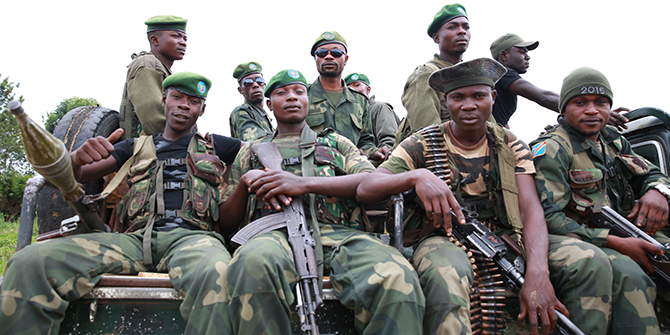Hate speech has been a constant feature in the dynamics of conflict in the Democratic Republic of Congo (DRC) over the last three decades. It primarily targets specific communities such as the Banyarwanda of North Kivu and Banyamulenge of South Kivu, whose citizenship, equal rights, and belonging have constantly been questioned. In their recent paper, Félix Mukwiza Ndahinda and Aggée Shyaka Mugabe examine the increasing role social media play in conflicts and mass violence from acting as a recruitment tool to triggering the emergence of shared online identities produced through socialisation within radical, extremist, or terrorist networks.
Between the end of May and the beginning of June 2022, multiple graphic images, inciteful rhetoric, and acts of violence targeting the Kinyarwanda-speaking, particularly the Tutsi population of eastern DRC, were widely shared on traditional and social media platforms. Triggered by the resumption of fighting between the M23 armed rebels and the Congolese armed forces, these violent demonstrations in multiple Congolese cities, including Goma, Kinshasa, Bukavu, and Kalima, drew global condemnation and calls for de-escalation. DRC authorities accused Rwanda of supporting the rebellion, but Rwanda denied the accusations.
At the height of the violent demonstrations, names of individuals and personal addresses of persons identified as Rwandans were read out in public to overheated mobs. Some individuals captured during ensuing attacks were lynched and cannibalised. Subsequent demonstrations targeted the United Nations Organization Stabilization Mission in the Democratic Republic of the Congo (MONUSCO) for failing to stop the violence.
These tragic events sadly corroborated the main findings in our paper about how hate speech disseminated on Congolese social media operates. Social media platforms connect a diversity of actors, including political operatives at the local and national level, leaders and members of active armed groups, civil society organisations, and diaspora communities. They facilitate the creation and dissemination of messages to wider audiences in ways that embolden actors in need of anonymity or a sense of community.
Interactions on radical social media platforms produce increasingly scripted, often hateful, narratives defining the ingroup and outgroup. Exchanges within these relatively safe spaces amplify and normalise hate speech, conspiracy theories, and violence by connecting actors across distant geographic locations. In a context where large sections of the population, particularly the youth, use social media as the main source of information, there is a manipulative potential for hateful narratives disseminated on interactive platforms.
Social and traditional media content and interactions reflect the multifaceted dimensions of the current conflicts in the DRC, while some narratives recycle familiar anti-Tutsi tropes and conspiracy theories popularised under Rwanda’s hate media preceding the 1994 genocide against the Tutsi. The core claim reproduced in most material describes the DRC as a country under foreign (Tutsi-Hima) political and military occupation since the mid-1990s. The occupation is imagined as seeking to control Congolese lands and mineral riches, subjugate the “natives,” divide the country, and, ultimately, establish a Tutsi-Hima empire across the entire region. Despite being established on Congolese territory for several generations, the Banyarwanda of North Kivu and the Banyamulenge of South Kivu are collectively identified as alien agents of the occupation. Socio-political exclusion, the rejection of equal citizenship, participation, and land rights were motivating factors for the involvement of individual actors from these two communities in different rebellions and wars since the mid-1990s.
In addition to being labelled as foreign invaders, occupants, and hegemonists, Congolese Banyarwanda, Banyamulenge, or Tutsi in general, are frequently portrayed as snakes, vipers, cockroaches, vermin, chameleons, greedy, deceptive, manipulators, and ruthless killers. These dehumanizing attributes are routinely invoked to justify violence, including killing members of these communities in what is construed as acts of self-defence.
The documentation and analysis of the dynamics of hate speech and conspiracy theories on Congolese social media indicate a total absence of action in mediating content. The DRC lacks appropriate legislation or coherent policy to address hate speech in general or regulate social media in particular. Foreign countries hosting large Congolese diaspora communities involved in the dissemination of hate speech (for instance, Belgium, France, the UK, the USA, and South Africa) have also failed to take any meaningful action to curb the use of their territories as sites for the dissemination of hate speech.
Social media service providers such as Facebook (WhatsApp), Google (YouTube), and Twitter seem unable or unwilling to enforce their own rules regarding the dissemination of hateful and violent content. In addition to common challenges that the moderation of online content faces, regardless of context, these platforms have not developed the needed capacity to filter content in “peripheral languages.”
Our inquiry into the nexus between hate speech and violence in eastern DRC shows how social media plays an increasingly important role in conflict situations by connecting actors and pushing lethal narratives across space and time. In the contemporary connected world where social media platforms constitute a major or single source of information, hateful narratives produced in remote locations have a direct impact on local terrains of armed hostilities and violence. Our study underscores the need for forceful action – in the form of legislation, policies, and enforcement – in response to the weaponisation of social media.
Photo: The populations of Mutaho flee into Goma following a second day of fighting between M23 elements and FARDC soldiers. Credit: MONUSCO/Clara Padovan. Licensed under CC BY-SA 2.0






Very interesting analysis.Could FDLR the extremist genocidaire terrorist armed group be behind the rise of this hate ideology in the region? Jean